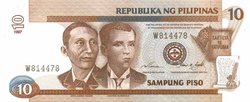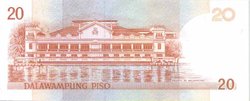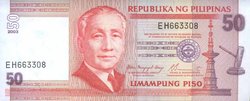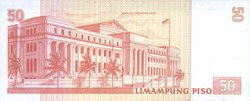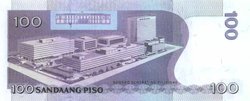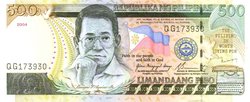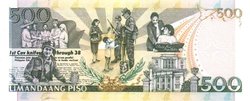Philippine peso bills
|
|
Philippine peso bills are issued by the Bangko Sentral ng Pilipinas (Central Bank of the Philippines) for circulation in the Philippines. The smallest amount of legal tender in wide circulation is twenty pesos and the largest is 1000 pesos. The front side of each bill features prominent people in the country's history while the reverse side depicts landmarks and events in history. In recent years, the 5 and 10 peso bills have been demonetized and replaced with coinage.
5 pesos
Php_bill_5_front.jpg
Front side of the 5-peso bill
Php_bill_5_back.jpg
Reverse side of the 5-peso bill
10 pesos
Php_bill_10_back.jpg
Reverse side of the 10-peso bill
20 pesos
Php_bill_20_front.jpg
Front side of the 20-peso bill
50 pesos
100 pesos
Php_bill_100_front.jpg
Front side of the 100-peso bill
200 pesos
Php_bill_200_front.jpg
Front side of the 200-peso bill
Php_bill_200_back.jpg
Reverse side of the 200-peso bill
500 pesos
1000 pesos
Php_bill_1000_front.jpg
Front side of the 1000-peso bill
Php_bill_1000_back.jpg
Reverse side of the 1000-peso bill
| Contents |
Bill descriptions
5 pesos
The front side of the 5-peso bill features the portrait of Emilio Aguinaldo. It also features the historical marker in Barasoain Church Convent, a cannon, and bank seal.
The back of the bill features the Philippine declaration of independence by Emilio Aguinaldo on June 12, 1898.
The bill is predominantly colored green.
Security features of the bill include a security thread, scattered red & blue visible fibers, and fluorescent printing.
The Bangko Sentral ng Pilipinas has stopped printing this banknote, and it is currently being replaced by equivalent coins. However, existing bills remain legal tender.
gie
10 pesos
The front side of the ten-peso bill features Apolinario Mabini on the left and Andres Bonifacio on the right. Both were members of the Katipunan, a secret society established by Bonifacio to fight the Spanish colonial government. Mabini was the society's respected adviser even though he was a cripple. Depicted on the right side is one of the flags of the Katipunan (see Flags of the Philippine Revolution), the Kartilya ng Katipunan, and a letter written by Mabini.
The reverse side of the bill features the Barasoain Church in Malolos, Bulacan, site of the first Philippine Congress and where the Malolos Constitution was drafted. The right portion depicts the initiation rites of the Katipunan. Members accepted into the society had to sign their name on the society's roster using their own blood.
Before 1998, the ten-peso bill only depicted Mabini and the Barasoain Church. In recent years, the new bill has been replaced with a 10 peso coin also bearing the effigies of Bonifacio and Mabini.
20 pesos
The front side of the 20-peso bill features Manuel L. Quezon, first president of the Commonwealth of the Philippines. Along the right side of the bill are the coat-of-arms of the Commonwealth, and two of Quezon's notable accomplishments. The first is Wikang Pambansa, which is Tagalog for "national language". In 1937, the National Language Institute was founded to establish a single national language for the Philippines. This eventually became the Filipino language, which is largely based on Tagalog. The second was the Saligang Batas 1935 or the 1935 Constitution of the Philippines. This was the first real constitution that was nationally effected and large parts of it survive in the current constitution.
The reverse side of the 20-peso bill depicts Malacaņan Palace, more popularly known as Malacaņang Palace, the residence of the President of the Philippines, along the banks of the Pasig River. Quezon was the first Philippine president to live in the Palace.
50 pesos
Depicted on the front side of the fifty-peso is Sergio Osmeņa, the second president of the Commonwealth of the Philippines. He served as president from 1944, after Quezon's death, to 1946, when the United States granted the Philippines' independence.
The National Museum is featured on the reverse side of the bill. This building used to be the old Executive House building during the American period and was labeled as such in the fifty-peso bill until recently.
100 pesos
The front side of the 100-peso bill features Manuel Roxas, the first president of the independent Philippine Republic. This independence is shown at the right side where the Philippine flag was raised and the American Stars and Stripes is lowered on July 4 1946.
The reverse side of the bill depicts the Manila compound of the Central Bank of the Philippines.
The 100-peso bill is the smallest-valued bill to have the new security features implemented in recent years. But before the advent of the new security features, the 100-peso bill is interesting for having other security features. On the front side is a barely visible "100" logo above the signatures of the president and the Central Bank governor. This logo is best seen on crisp new 100-peso bills. On the reverse side, the top row of windows of the main building has the words "Bangko Sentral ng Pilipinas" running the whole length.
200 pesos
The front side of the 200-peso bill features the portrait of Diosdado Macapagal. It also features the Aguinaldo Shrine in Kawit, Cavite.
The back side of the bill features a scene from EDSA II, with Gloria Macapagal-Arroyo, Macapagal's daughter, being sworn in as president by Chief Justice Hilario Davide Jr..
The bill is predominantly colored green. This note is also a commemorative banknote.
500 pesos
The front side of the 500-peso bill features the portrait of Benigno Aquino Jr.. To the right of the bill, there are two popular quotes from Aquino: "Faith in our people and faith in God", and "The Filipino is worth dying for". There is also the signature of Aquino, a typewriter with his initials ("B.S.A.J."), and a dove of peace. A Philippine flag is also to the right of his portrait, near the central part of the front side.
The reverse side features a collage of various images in relation to Aquino. He was (out of some of the pictures) a journalist for the Manila Times, a senator (the pioneer of the Study Now, Pay Later education program), the mayor in his hometown of Concepcion, the governor of Tarlac, and was the main driving force behind the People Power Revolution of 1986, some three years after his death in 1983.
Before this note was printed, 500-peso bill was to have Ferdinand Marcos until People Power Revolution when it was replaced by the current 500-peso bill. Remnants of this bill are only for media purposes
1000 pesos
The front side of the 1000-peso bill features the portraits of Jose Abad Santos, Chief Justice; Josefa Llanes Escoda, civic worker and one of the founders of the Girl Scouts of the Philippines; and Vicente Lim, a general in the Philippine Army, first Filipino graduate of West Point: the three are considered heroes of the resistance against the Japanese Occupation of the Philippines. It also features the eternal flame, laurel leaves, and bank seal.
The back of the bill features the Banaue Rice Terraces, Manunggul Jar cover and Langgal.
The bill is predominantly colored blue.
Security features of the bill include optically variable ink, a security thread, scattered red & blue visible fibers, and fluorescent printing. The words "Central Bank of the Philippines" are microprinted in the lower left border on the face of the note.
Higher denominations
The 100,000-peso centennial note, measuring 8.5"x14", is accredited by the Guinness Book of World Records as the world's largest legal tender note. It was issued in very limited quantity during the celebration of the centennial of Philippine independence in 1998. [[1] (http://www.bsp.gov.ph/about_bsp/moneymuseum/discover/page_08.htm)]

